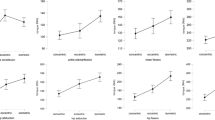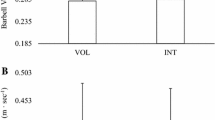Summary
Two studies were conducted in 83 college men to determine the degree of generality of individual differences in upper body muscular strength assessed by different testing modes. In study 1 (N=43), correlations were computed between four measures of upper body strength using the bench press movement, maximal isokinetic (0.09 rad·s−1), maximal fast (0.126 m·s−1) and slow (0.037 m·s−1) hydraulic, and one repetition maximum (1-RM) free weight bench press (BP). Compared to free weight BP, maximal strength during isokinetic and slow hydraulic BP was ∼29% and ∼8% larger, and fast hydraulic BP strength was ∼63% lower (p<0.05). Simple linear regression of isokinetic BP on 1-RM BP yieldedr=0.79, error of prediction (SE)=12%, and generality=81%. The corresponding averaged values for the regression of slow and fast hydraulic BP on free weight 1-RM BP werer=0.77, SE=13.5%, and generality=84%. In Study 2 (N=40), testing included maximal isokinetic concentric and eccentric arm flexion and extension at 0.524, 1.570, and 2.094 rad·s−1. The ratio of concentric to eccentric torque at the 3 speeds averaged 0.68 (flexion) and 0.70 (extension), and eccentric torques were 32% and 30% greater than concentric torques (p<0.05). The linear regression between concentric vs. eccentric flexion and extension torques at the three velocities yielded an averager=0.80, SE=13.7%, and generality=73%. The findings from both studies provide evidence for generality of concentric muscle forces obtained during isokinetic, hydraulic, and 1-RM BP movement, and concentric and eccentric torque measured at 3 velocities for simple arm flexion and extension. Thus, individuals who performed well (or poorly) on one type of upper body strength test were able to achieve the same relative level of performance when tested by different contraction modes.
Similar content being viewed by others
References
Abbott BC, Bigland B, Ritchie JM (1952) The physiological cost of negative work. J Physiol 117:380–390
Aghazadeh F, Ayoub MM (1985) A comparison of dynamic- and static-strength models for prediction of lifting capacity. Ergonomics 28:1409–1417
Asmussen E, Hansen D, Lammert O (1965) The relation between isometric and dynamic muscle strength in man. Communication from the Testing Observation Institute of the Danish National Association for Infantile Paralysis. No 20
Åstrand PO, Rodahl K (1986) Textbook of work physiology. McGraw-Hill, New York
Bennett JG, Stauber WT (1986) Evaluation and treatment of anterior knee pain using eccentric exercise. Med Sci Sports Exerc 18:526–530
Carlson RB (1970) Relationship between isometric and isotonic strength. Arch Physiol Med Rehab 51:176–179
Cavagna GA, Dusman B, Margaria R (1968) Positive work done by a previously stretched muscle. J Appl Physiol 24:21–32
Clarke DH, Henry FM (1961) Neuromotor specificity and increased speed from strength development. Res Q 32:315–325
Clarke DH, Clarke HH (1970) Research processes in physical education, recreation, and health. Prentice-Hall, Englewood Cliffs, New Jersey
Cooney MM, Walker JB (1986) Hydraulic resistance exercise benefits cardiovascular fitness of spinal cord injured. Med Sci Sports Exerc 18:522–525
Doss WS, Karpovich PV (1965) A comparison of concentric, eccentric, and isometric strength of elbow flexors. J Appl Physiol 20:351–353
Ferguson GA (1976) Statistical analysis in psychology and education. McGraw-Hill, New York
Griffin JW (1987) Differences in elbow flexion torque measured concentrically, eccentrically, and isometrically. Physiol Ther 67:1205–1208
Highgenboten CL, Jackson AW, Meske NB (1988) Concentric and eccentric torque comparisons for knee extension and flexion in young adult males and females using the Kinetic Communicator. Am J Sports Med 16:234–237
Hortobagyi T, Katch FI, LaChance PF (1988) Effects of simultaneous training for strength and endurance on upper and lower body strength and running performance in college males. Can J Sport Sci 13:57 P
Jacobs I, Pope J (1986) A computerized system for muscle strength evaluation: measurement reproducibility validity and some normative data. Natl Strength Cond Assoc J 8:28–33
Jacobs I, Bell DG, Pope J (1988) Comparison of isokinetic and isoinertial lifting tests as predictors of maximal lifting capacity. Eur J Appl Physiol 57:146–153
Kamon E, Kiser D, Pytel JL (1982) Dynamic and static lifting capacity and muscular strength of steelmill workers. Am Ind Hyg Assoc J 43:853–857
Kleinbaum DG, Kupper LL (1978) Applied regression analysis and other multivariate methods. Duxbury Press, Boston
Knapik JJ, Ramos MU (1980) Isokinetic and isometric torque relationships in the human body. Arch Phys Med Rehab 61:64–67
Knapik JJ, James MS, Wright JE, Mawdsley RH, Braun JM (1983a) Isokinetic isometric and isotonic strength relationship. Arch Phys Med Rehab 64:77–80
Knapik JJ, Wright JE, Mawdsley RH, Braun JM (1983b) Isometric isotonic and isokinetic torque variations in four muscle groups through a range of joint motion. Phys Ther 63:938–947
LaChance PF, Hortobagyi T, Katch FI, Janney C (1987) Effects of free weight and hydraulic resistance training evaluated by free weights and hydraulic and isokinetic tests. Med Sci Sports Exerc 19:S 88
Lander JE, Bates BT, Sawhill JA, Hamill J (1985) A comparison between free-weight and isokinetic bench pressing. Med Sci Sports Exerc 17:344–353
Mital A, Karwowski W, Mazouz AK, Orsarh E (1986) Prediction of maximum acceptable weight of lift in the horizontal and vertical planes using simulated job dynamic strengths. Am Ind Hyg Assoc J 5:288–292
Moritani T, Muramatsu S, Muro M (1988) Activity of motor units during concentric and eccentric contractions. Am J Phys Med 66:338–350
Olson VL, Smidt GL, Johnston RC (1972) The maximum torque generated by the eccentric, isometric, and concentric contractions of the hip abductor muscles. Phys Ther 52:149–157
Osternig LR, Bates BT, James SL (1977) Isokinetic and isometric torque force relationships. Arch Phys Med Rehab 58:254–257
Otis JC (1976) Relationship of isometric and isokinetic torques. J Biomech 9:488
Pytel JL, Kamon E (1981) Dynamic strength test as a predictor for maximum acceptable lifting. Ergonomics 24:663–672
Rasch PJ (1957) Relationship between maximum isometric tension and maximum isotonic elbow flexion. Res Q 28:85
Rasch PJ, Pierson WR (1960) Relationship between maximum isometric tension and breaking strength of forearm flexors. Res Q 31:534–535
Rothwell JC (1987) Control of human voluntary movement. Croom Helm, London
Sage GH (1984) Motor learning and control. WC Brown Publishers, Dubuque
Singh M, Karpovich PV (1966) Isotonic and isometric forces of forearm flexors and extensors. J Appl Physiol 21:1435–1437
Tabachnik G, Fidell LS (1983) Using multivariate statistics. Harper and Row, New York
Tredinnick TJ, Duncan PW (1988) Reliability of measurements of concentric and eccentric isokinetic loading. Physiol Ther 68:656–659
Weltman A, Janney C, Rians CB, Strand K, Berg B, Tippitt S, Wise J, Cahill BR, Katch FI (1986) The effects of hydraulic resistance strength training in pre-pubertal males. Med Sci Sports Exerc 18:629–638
Wilkie DR (1950) The relation between force and velocity in human muscle. J Physiol 110:249–280
Author information
Authors and Affiliations
Rights and permissions
About this article
Cite this article
Hortobagyi, T., Katch, F.I. & LaChance, P.F. Interrelationships among various measures of upper body strength assessed by different contraction modes. Europ. J. Appl. Physiol. 58, 749–755 (1989). https://doi.org/10.1007/BF00637387
Accepted:
Issue Date:
DOI: https://doi.org/10.1007/BF00637387




